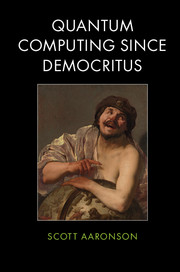Book contents
- Frontmatter
- Dedication
- Contents
- Preface
- Acknowledgments
- 1 Atoms and the void
- 2 Sets
- 3 Gödel, Turing, and friends
- 4 Minds and machines
- 5 Paleocomplexity
- 6 P, NP, and friends
- 7 Randomness
- 8 Crypto
- 9 Quantum
- 10 Quantum computing
- 11 Penrose
- 12 Decoherence and hidden variables
- 13 Proofs
- 14 How big are quantum states?
- 15 Skepticism of quantum computing
- 16 Learning
- 17 Interactive proofs, circuit lower bounds, and more
- 18 Fun with the Anthropic Principle1
- 19 Free will
- 20 Time travel
- 21 Cosmology and complexity
- 22 Ask me anything
- Index
- References
20 - Time travel
Published online by Cambridge University Press: 05 April 2013
- Frontmatter
- Dedication
- Contents
- Preface
- Acknowledgments
- 1 Atoms and the void
- 2 Sets
- 3 Gödel, Turing, and friends
- 4 Minds and machines
- 5 Paleocomplexity
- 6 P, NP, and friends
- 7 Randomness
- 8 Crypto
- 9 Quantum
- 10 Quantum computing
- 11 Penrose
- 12 Decoherence and hidden variables
- 13 Proofs
- 14 How big are quantum states?
- 15 Skepticism of quantum computing
- 16 Learning
- 17 Interactive proofs, circuit lower bounds, and more
- 18 Fun with the Anthropic Principle1
- 19 Free will
- 20 Time travel
- 21 Cosmology and complexity
- 22 Ask me anything
- Index
- References
Summary
In the last chapter, we talked about free will, superintelligent predictors, and Dr. Evil planning to destroy the Earth from his moon base. Now I’d like to talk about a more down-to-earth topic: time travel. The first point I have to make is one that Carl Sagan made: we're all time travelers – at the rate of one second per second! Har har! Moving on, we have to distinguish between time travel into the distant future and into the past. Those are very different.
Travel into the distant future is by far the easier of the two. There are several ways to do it.
Cryogenically freeze yourself and thaw yourself out later.
Travel at relativistic speed.
Go close to a black hole horizon.
This suggests one of my favorite proposals for how to solve NP-complete problems in polynomial time: why not just start your computer working on an NP-complete problem, then board a spaceship traveling at close to the speed of light and return to Earth to pick up the solution? If this idea worked, it would let us solve much more than just NP. It would also let us solve PSPACE-complete and EXP-complete problems – maybe even all computable problems, depending on how much speedup you want to assume is possible. So what are the problems with this approach?
Information
- Type
- Chapter
- Information
- Quantum Computing since Democritus , pp. 307 - 324Publisher: Cambridge University PressPrint publication year: 2013
